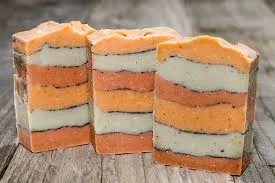There are several ways to layer soap making supplies to produce a unique-looking soap. Learning how to use these techniques allows you to create one-of-a-kind crafts. Several different methods can help mold your soap into a unique vision. Here are innovative techniques for layering soap colors.
Gradient Ombré
The gradient ombré technique results in soap with colors that change shades. Initially, work with the darkest color in your desired gradient, using it as the base. As you progress through the layers, gradually add more white-colored soap for efficient lightening. For the process to be successful, mixing the soap making supplies must be done at the right moment. You can create gradients that mimic the colors of autumn, ranging from dark rust to light amber. The transition from one color to another appears smooth, rather than having strong lines between them. Multiple layers in products are sometimes enhanced with exfoliants, such as poppy seeds or coffee grounds, to add more texture. It pairs well with blues, purples, or neutral colors to achieve a professional and elegant finish.
Suspended Drop Technique
For this technique, pour a first layer of soap and let it rest to develop its surface tension slightly. A suspended effect is seen by dropping opposite colors of soap from several inches upwards onto the base. A part of the soap sinks into the firming base, even though it continues to look either like a sphere or a teardrop. Crafters increase the shine by using special additives such as botanical pigments, clay, or mica powders. Adjusting the angle at which the thread drops can affect the depth of the bars and make your art look more complex.
Ghost Layers
You can get a translucent effect by using natural pigments such as spirulina, indigo, or madder root. During the pour, it is necessary to manage the temperature to avoid the soap from melting and mixing. Soap makers might add dried flowers or other herbs into the layers where they are not visible. By combining clean and semi-transparent parts, the bar soap resembles an artistic sculpture more than a typical bar of soap. You can arrange the tiles to create patterns such as waves, diagonals, or circles within the house to make it look more appealing.
Thermal Transfer Layering
Thermal transfer layering enables bath water to spontaneously produce patterns that resemble natural features, such as rivers and clouds. You should alternate between hot and cold soaps, rather than letting them reach the same temperature. Heat changes can result in glossy finishes on the colors or give an impression of blurring into one another. Some artisans use certain substances, such as clays and botanical powders, that alter their behavior when heated. These patterns develop naturally in the saponification process without the use of tools typically used for swirling. Some people add insulation with blankets or
Compare Soap Making Supplies
Experiment with various colors to layer your images in different ways. Initially, focus on creating designs that feature only two colors, and then gradually branch out to multi-hued creations. Decide on a desired technique and start exploring your creativity. Choose a different layering technique at the beginning of each process to learn and grow your skills. Get the right soap making supplies today to start your projects.



